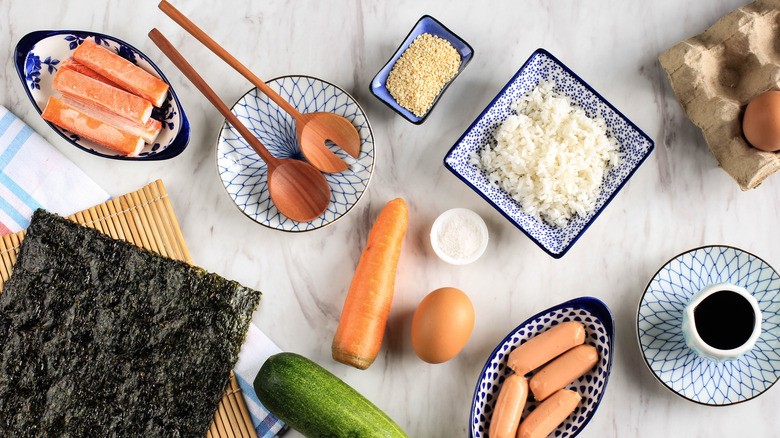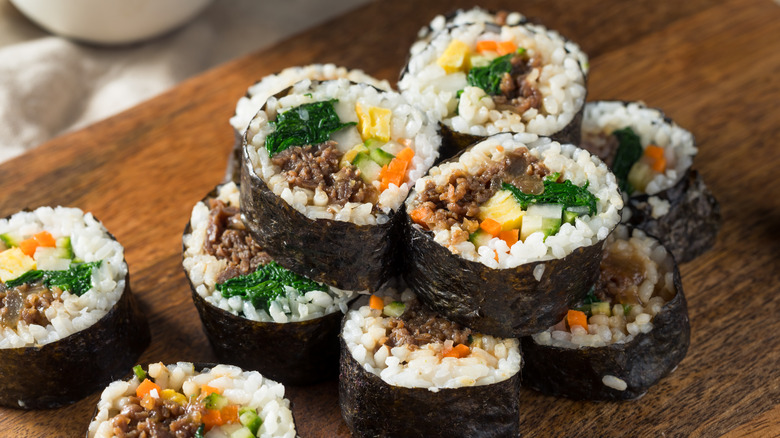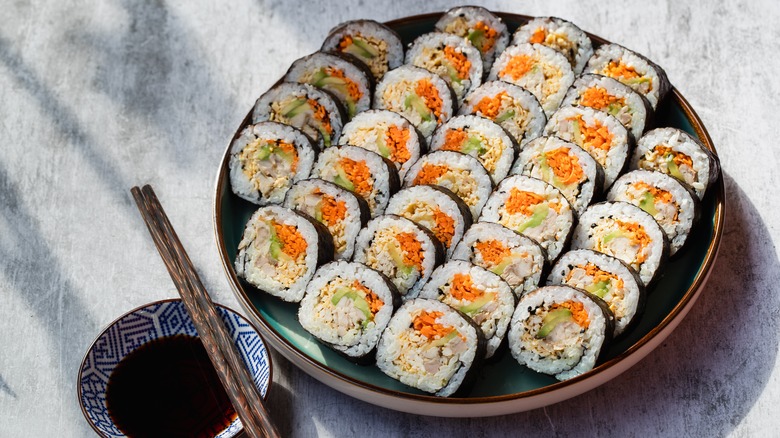The Unique, Expert-Approved Kimbap Combos You Need To Try
If you've been trying your hand at making kimbap at home and looking to spice things up with the filling, you've come to the right place. We reached out to James Beard Award Best Chef semifinalist Ji Hye Kim, owner of the Korean restaurant Miss Kim in Ann Arbor, Michigan, about how to breathe new life into kimbap, and she did not disappoint.
For those of you who don't know, kimbap is a Korean dish that translates to seaweed and rice. It's often compared to Japanese sushi because they share the very distinct look of seaweed wrapped around rice and filling, but once you take a bite of kimbap, you know there's a world of difference. For one, kimbap seasons its rice with sesame oil instead of rice vinegar. In addition, kimbap doesn't use raw fish as an ingredient. Instead, a typical kimbap roll is served with carrots, pickled radish, scallions, fried egg, bulgogi beef, spinach, and fish cake (odeng). But if you're looking for a fresh take on an old favorite, Kim gave us three of her favorite kimbap combos for you all to try out.
Smoked salmon and cucumber
Inspired by Zingerman's Delicatessen in Ann Arbor, Michigan, Kim starts this dish by seasoning the rice with some poppy seeds, sesame seeds, sesame oil, and sea salt. She then prepares the filling, starting with smoked salmon, which she slices up so it will roll easier. Onion and cucumber are then julienned, which is chef jargon for cut into long, thin strips. She'll even add slivers of ripe avocado if she's feeling fancy.
Now that she has all of the ingredients, it's time to roll the kimbap. Once it's rolled and cut into pieces, she tops it off with a delicious sprinkle of capers. If you don't have capers on hand, you can substitute a sprinkle of sea salt to get that little extra salty, crunchy kick. You're all set to take these little beauties to the park for a picnic or, if you just can't wait, to scarf them down on the spot.
Pork belly, kimchi, and egg
Korean pork belly is dangerously good, and this combo has our mouths watering. A typical marinade for Korean pork belly includes the iconic Korean chili paste gochujang, the Korean chili powder gochugaru, honey, soy sauce, ginger, and sesame oil. Combine it with arguably Korea's number one food staple, kimchi, and you've got a dish that's ready to explode.
Kim adds fried egg for some nice yellow color and to add to the body. She also adds slices of bell pepper and jalapeño, which really cranks this combo up to an eleven in terms of wow factor. There is nothing muted about this kimbap recipe and, if you're looking to impress someone with a flavor parade, this is a great way to show off your cooking skills. Kim recommends squeezing the kimchi out until the juices are gone. Otherwise, you risk making your kimbap soggy, which will ruin its shape.
Tuna salad and avocado
If big, bold flavors with a good amount of heat aren't your thing, tone it down with this casual combo. You'll prepare the rice the same way you did for the smoked salmon and cucumber kimbap, with sesame oil and sesame seeds. Then make your tuna salad. Don't forget, this isn't sushi, so you'll want cooked tuna. Store-bought canned tuna works great; just open up a can or two and mix it together with some mayonnaise. Chopped celery makes a great addition, as do olives. Don't forget to put some crushed black pepper in. If you want to keep the Korean flavors front and center, try putting some gochujang in as well.
Once your tuna salad is ready and sitting on top of the rice, add some julienned cucumber as well as slices of avocado. This combo is really easy to make but still manages to be a super unique spin on the classic kimbap formula. Of course, kimbap is as versatile as you are creative. Don't be afraid to make your own spin on these delicious versions.



